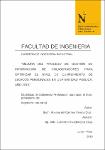Mostrar el registro sencillo del ítem
Diseño de un sistema de video vigilancia IP para la Corte Superior de Justicia - La Libertad
| dc.contributor.advisor | Rodríguez Novoa, César | |
| dc.contributor.author | Peláez Salvador, Juan Alexander | |
| dc.date.accessioned | 2014-06-24T18:32:11Z | |
| dc.date.available | 2014-06-24T18:32:11Z | |
| dc.date.issued | 2013-10-14 | |
| dc.identifier.citation | Peláez, J. A. (2013). Diseño de un sistema de video vigilancia IP para la Corte Superior de Justicia - La Libertad. (Tesis de licenciatura). Repositorio de la Universidad Privada del Norte. Recuperado de http://hdl.handle.net/11537/1371 | es_PE |
| dc.identifier.other | TES 004.68 PELA 2013 | es_PE |
| dc.identifier.uri | https://hdl.handle.net/11537/1371 | |
| dc.description.abstract | RESUMEN Se realizó un estudio técnico para la Corte Superior de Justicia - La Libertad, orientado a diseñar un sistema de Video Vigilancia IP, lo cual es una tecnología de vigilancia visual que combina los beneficios analógicos de los tradicionales CCTV (Circuito Cerrado de Televisión) con las ventajas digitales de las redes de comunicación IP (Internet Protocol), lo cual permite la supervisión local y/o remota de imágenes y audio así como el tratamiento digital de las imágenes. Existe una gama muy amplia de cámaras con diferentes funcionalidades para satisfacer todas las necesidades y presupuestos. Tanto el análisis y diseño de la red se han desarrollado adoptando la metodología propuesta por CISCO TOP DOWN, que se divide en etapas: El objetivo es diseñar un sistema de Video Vigilancia IP, el cuál permita vigilar y controlar a todo el personal para así poder disminuir las pérdidas de los activos. 1. Diseñar un sistema de Video Vigilancia IP para una supervisión continua de los datos enviados por la cámara IP. 2. Diseñar la red lógica y física de la Video Vigilancia IP. 3. Propuesta de un plan de capacitación de personal involucrado en el manejo de los equipos de video vigilancia IP. A continuación presentamos un resumen de todos los capítulos de este presente Proyecto de Tesis: Capítulo I: El plan de Investigación, se enfocará en la situación problemática actual de la Corte Superior de Justicia de la Libertad, que es la pérdida de activos y de expedientes judiciales, se formulará el problema, luego la hipótesis y por último se identificará los objetivos principales. Capítulo II: Marco Teórico, es toda la información capturada de acuerdo al Título del presente Proyecto de Tesis, tomando en cuenta los puntos más importantes en cuanto a la investigación buscada por el Tesista, como por ejemplo ¿Qué es la Video vigilancia IP?, ¿cuantos tipos de modelos de Cámaras IP existen?, ¿Qué modelo debo usar? y ¿Cuánto de ancho de banda se consumirá?. Capítulo III: Planteamiento de la hipótesis, identificamos las variables independientes e dependientes, luego lo plasmamos a una tabla la operacionalización de las variables, la descripción de los indicadores con su respectiva fórmula y operatividad. Capítulo IV: Marco Institucional, enfocándose en la descripción de la empresa, dirección empresarial, organización empresarial, mapa geográfico y las áreas funcionales que la conforman en la CSJLL, dicho contenido es la información, estudio, análisis del presente proyecto de tesis. Capítulo V: Se enfocará principalmente en el desarrollo de la propuesta Técnico Metodológica, la metodología del Diseño de redes TOP DOWN - 3ra Edición, lo cuál está dividida en 4 Fases: - Diseño del producto - Fase I: Identificación de las necesidades de los clientes y objetivos, esta fase comienza con la identificación de los objetivos de negocio y de sus requerimientos técnicos.- Fase II: Diseño de la Red Lógica, el diseñador de la red desarrolla una topología de red, dependiendo del tamaño de las características de la red y del tráfico, la topología puede variar desde simples a complejos, requiriendo la jerarquía y modularidad. El diseñador de la red también diseña un modelo de capa de direccionamiento de red y selecciona la conmutación y los protocolos de enrutamiento. Los puntos más relevantes en esta fase son: - Diseño de la Interconexión de los campus - Dimensionamiento de la capacidad de los enlaces - Tráfico - Ancho de banda requerido para los enlaces - Fase III: Diseño de la Red Física WAN, se hace la selección de las tecnologías y dispositivos para redes de campus, incluyendo interruptores de cableado, Ethernet, puntos de accesos inalámbricos, puentes inalámbricos y routers. - Fase IV: Diseño de la red WAN, los pasos finales en el diseño de la red Top Down, poner en práctica un plan de pruebas, construir un prototipo piloto, optimizar el diseño de la red, y documentar su trabajo con una propuesta de diseño de la red. - Desarrollo de la Propuesta Se enfocará en el Desarrollo de la presente Tesis, aplicando las 4 fases de la red TOP DOWN, haciendo un respectivo análisis de la red, ¿cuánto será el consumo de ancho de banda de las cámaras IP en la marca Samsung?, además diseñaremos la red física y lógico, el direccionamiento IP, el cableado horizontal y vertical, y de la metodología utilizada para el diseño de la arquitectura, el software de grabación NET-i ware y NET-i WEB Viewer, los protocolos a usar, entre otros. Capítulo VI: Materiales y métodos, el tipo de investigación (Propósito y investigación), además del diseño de la investigación (Población y muestra) y finalmente de las técnicas, procedimientos e instrumentos a usar (Prueba T student y Z). Capítulo VII: Son los Resultados obtenidos en la contrastación, son las pruebas estadísticas por cada indicador cuantitativo y cualitativo. Las dos pruebas estadísticas a aplicar son T-student y Z. Capítulo VIII: Se enfoca principalmente en la Discusión de los Resultados, haciendo el respectivo análisis con cada uno de los indicadores tanto cuantitativo y cualitativo planteándolos, mostrándolos en tablas y gráficos respectivamente. Y finalmente las conclusiones finales del presente Proyecto de Tesis mencionado, destacando lo más importante del porque usar la Video vigilancia IP y a futuro que se obtendrá?, que pasará?. Las recomendaciones para está propuesta de Tesis, que puntos serian lo más recomendable teniendo en cuenta si es entendible para el usuario peruano al aplicar dicho Sistema de Video Vigilancia IP para la Corte Superior de Justicia - La Libertad. Las fuentes bibliográficas, que son una lista de las páginas web visitadas por el Tesista, poniendo el día que lo visitó, la dirección web, agregando el tema, Libros o Tesis, Direcciones electrónicas. El glosario de términos, seleccionando las palabras nuevas de toda la presente Tesis, haciendo una lista escribiendo su significado. Los anexos, planos lógicos de la red video vigilancia IP, cableado de la red de los 4 pisos, además de las figuras físicas y del cableado de la Azotea, la Factibilidad Económica, la instalación del “pozo a tierra” y de las especificaciones técnicas de cada cámara IP, entre otros. | es_PE |
| dc.description.abstract | ABSTRACT We conducted a technical study for the Superior Court of Justice - Freedom, aimed at designing a system of IP Video Surveillance, which is a visual surveillance technology that combines the benefits of traditional analog CCTV (Closed Circuit Television) with advantages of digital communication networks, IP (Internet Protocol), which allows local monitoring and / or remote images, and audio and digital treatment of images. There is a wide range of cameras with different features to suit all needs and budgets. Both, Analysis and Design of the network were developed by adopting the methodology proposed by CISCO TOP DOWN, which is divided in stages. The objective is to design an IP video surveillance system, which allows the monitoring and controlling all personnel in order to reduce losses of assets. 1. Designing an IP Video Surveillance system for continuous monitoring of the data sent by the IP camera. 2. Designing the logical and physical network of IP Video Surveillance. 3. Proposal of a training plan of personnel involved in handling of IP video surveillance equipment. Below is a summary of all the chapters of this present thesis project: Chapter I: Research plan will focus on the current problem situation Superior Court of Justice - the Liberty, which is the loss of assets and judicial case files the problem is formulated, then the hypothesis and finally identify the main objectives. Chapter II: Theoretical Framework, all information is captured under Title of this thesis project, taking into account the most important in terms sought by the Thesist research, such as What is IP Video Surveillance?, How many types IP Cameras models exist, What model should I use? and How much bandwidth is consumed?. Chapter III: Stating the hypothesis, identify the independent and dependent variables, then it can form a table operationalization of the variables, the description of the indicators with their respective formula and operability. Chapter IV: Institutional Framework, focusing on business description, business address, business organization, geographic map and the functional areas that comprise the CSJLL, that content is information, study, analysis of this thesis project. Chapter V: It will focus primarily on the development of the proposed Technical Methodology, the methodology of Network Design TOP DOWN - 3rd Edition, so whats divided into 4 phases: - Product Design - Phase I: Identifying customer needs and objectives, this phase begins with the identification of business goals and technical requirements - Phase II: Logical Network Design The network designer develops a network topology, depending on the size of the network characteristics and traffic, the topology can vary from simple to complex, requiring the hierarchy and modularity. The network designer also designs a model of network layer routing and switching and selecting routing protocols. The most relevant in this phase are: - Interconnection Campus Design - Sizing of the link capacity - Traffic - Bandwidth required for links - Phase III: Physical Network Design WAN, it is the selection of technologies and devices for campus networks, including wired switches, Ethernet, wireless access points, wireless bridges and routers. - Phase IV: WAN design, the final steps in the design of the top-down network, implement a test plan, build a prototype pilot, optimize network design, and document their work with a proposal network design. - Proposal Development It will focus on the development of the present Thesis, applying the four phases of the TOP DOWN, by a respective network analysis, how will the bandwidth consumption of the IP cameras on the Samsung brand?, And design the physical and logical network, IP routing, horizontal and vertical wiring, and the methodology used for the design of architecture, writing software NET-i ware and wEB NET-i Viewer, protocols to use, among others. Chapter VI: Materials and methods, the type of research (Purpose and research), and research design (population and sample) and finally the techniquesprocedures and instruments to use (student t-test and Z) Chapter VII: Are the results obtained in the matching are statistical tests for each quantitative and qualitative indicator. The two statistical tests to be applied are T-student and Z. Chapter VIII: It focuses mainly on the Discussion of Results, making the respective analysis with each of the indicators, both quantitative and qualitative raising them, displaying them in tables and graphs respectively. And finally the final conclusions of this thesis project mentioned, highlighting the most important because using the Video IP Surveillance and future that will be obtained?, Who will?. Recommendations for Thesis’s proposal, which would be the most recommended items according to whether it is understandable for the user to apply the Peruvian IP Video Surveillance System for the Superior Court of Justice - the Liberty. The bibliographical sources that are a list of websites visited by the Thesis, putting the day I visited, the web address, adding the topic, Books, Theses, Electronic addresses. The glossary of terms, selecting new words throughout this thesis, listing their meaning writing. The Annexes: logical planes IP video surveillance network, network wiring of the 4 floors, plus physical figures and roof wiring, Economic Feasibility, installing the “well grounded” and technical specifications of each IP camera, among others. | en_US |
| dc.description.uri | Tesis | es_PE |
| dc.format | application/pdf | es_PE |
| dc.language.iso | spa | es_PE |
| dc.publisher | Universidad Privada del Norte | es_PE |
| dc.rights | info:eu-repo/semantics/openAccess | es_PE |
| dc.source | Repositorio Institucional - UPN | es_PE |
| dc.source | Universidad Privada del Norte | es_PE |
| dc.subject | TCP/IP | es_PE |
| dc.subject | Redes de comunicaciones | es_PE |
| dc.subject | Tecnología audiovisual | es_PE |
| dc.title | Diseño de un sistema de video vigilancia IP para la Corte Superior de Justicia - La Libertad | es_PE |
| dc.type | info:eu-repo/semantics/bachelorThesis | es_PE |
| thesis.degree.grantor | Universidad Privada del Norte. Facultad de Ingeniería | es_PE |
| thesis.degree.level | Título Profesional | es_PE |
| thesis.degree.discipline | Ingeniería de Sistemas Computacionales | es_PE |
| thesis.degree.name | Ingeniero de Sistemas Computacionales | es_PE |
| dc.publisher.country | PE | es_PE |
| dc.subject.ocde | https://purl.org/pe-repo/ocde/ford#2.02.04 | es_PE |
| thesis.degree.program | Pregrado | es_PE |
| dc.description.sede | Trujillo San Isidro | es_PE |
| renati.discipline | 612086 | es_PE |
| renati.level | https://purl.org/pe-repo/renati/level#tituloProfesional | es_PE |
| renati.type | https://purl.org/pe-repo/renati/type#tesis | es_PE |
Ficheros en el ítem
Este ítem aparece en la(s) siguiente(s) colección(ones)
-
Tesis [237]






